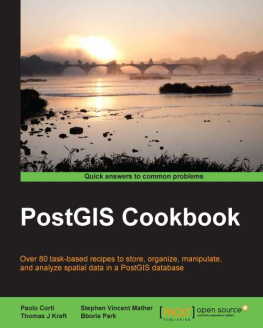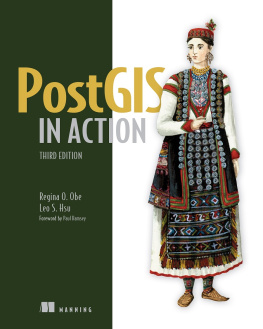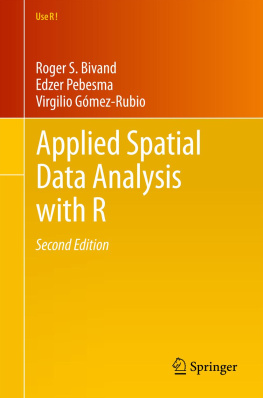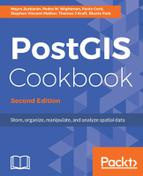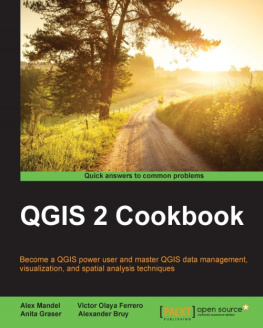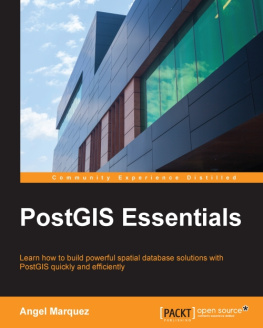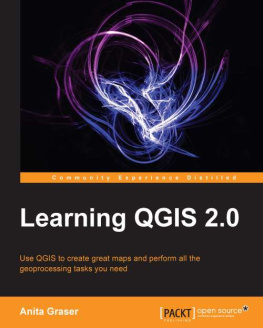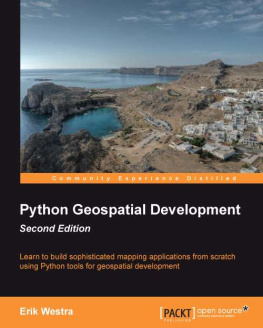Corti - PostGIS 2.0 Cookbook
Here you can read online Corti - PostGIS 2.0 Cookbook full text of the book (entire story) in english for free. Download pdf and epub, get meaning, cover and reviews about this ebook. year: 2014, publisher: Packt Publishing, genre: Computer. Description of the work, (preface) as well as reviews are available. Best literature library LitArk.com created for fans of good reading and offers a wide selection of genres:
Romance novel
Science fiction
Adventure
Detective
Science
History
Home and family
Prose
Art
Politics
Computer
Non-fiction
Religion
Business
Children
Humor
Choose a favorite category and find really read worthwhile books. Enjoy immersion in the world of imagination, feel the emotions of the characters or learn something new for yourself, make an fascinating discovery.
PostGIS 2.0 Cookbook: summary, description and annotation
We offer to read an annotation, description, summary or preface (depends on what the author of the book "PostGIS 2.0 Cookbook" wrote himself). If you haven't found the necessary information about the book — write in the comments, we will try to find it.
- Integrate PostGIS with web frameworks and implement OGC standards such as WMS and WFS using MapServer and GeoServer
- Convert 2D and 3D vector data, raster data, and routing data into usable forms
- Visualize data from the PostGIS database using a desktop GIS program such as QGIS and OpenJUMP
- Easy-to-use recipes with advanced analyses of spatial data and practical applications
If you are a web developer or a software architect, especially in location-based companies, and want to expand the range of techniques you are using with PostGIS, then this book is for you. You should have some prior experience with PostgreSQL database and spatial concepts.
What You Will Learn- Import and export geographic data from the PostGIS database using the available tools
- Structure spatial data using the functionality provided by the combination of PostgreSQL and PostGIS
- Work with a set of PostGIS functions to perform basic and advanced vector analyses
- Connect PostGIS with Python
- Learn to use programming frameworks around PostGIS
- Maintain, optimize, and fine-tune spatial data for long-term viability
- Explore the 3D capabilities of PostGIS, including LiDAR point clouds and point clouds derived from Structure from Motion (SfM) techniques
- Distribute 3D models through the Web using the X3D standard
- Use PostGIS to develop powerful GIS web applications using Open Geospatial Consortium web standards
- Master PostGIS Raster
PostGIS is a spatial database that integrates advanced storage and analysis of vector and raster data, and is remarkably flexible and powerful. PostGIS provides support for geographic objects to the PostgreSQL object-relational database and is currently the most popular open source spatial databases. If you want to explore the complete range of PostGIS techniques and expose the related extensions, this book is a must-have.
This book is a deep-dive into the full range of PostGIS topics, with practical applications of the concepts and code. It is a comprehensive guide on PostGIS tools and concepts which are required to manage, manipulate, and analyse spatial data in PostGIS. This book is packed with systematic instructions of hands-on examples and in-depth explanations. Even for experienced users, this book will serve as a great source of reference by providing new ways of working with PostGIS through the books easy-to-follow approach.
This hands-on guide looks at key spatial data manipulation tasks, explaining not only how each task is performed, but also why. It provides practical guidance allowing you to safely take advantage of the advanced technology in PostGIS in order to simplify your spatial database administration tasks.
This practical book will help you take advantage of basic and advanced vector, raster, and routing approaches. You will learn to use the concepts of data maintenance, optimization, and performance, which will help you to integrate these into a large ecosystem of desktop and web tools.
With this comprehensive guide, you will be armed with all the tools and instructions you need to both manage the spatial database system and make better decisions as your projects requirements evolve.
Corti: author's other books
Who wrote PostGIS 2.0 Cookbook? Find out the surname, the name of the author of the book and a list of all author's works by series.

